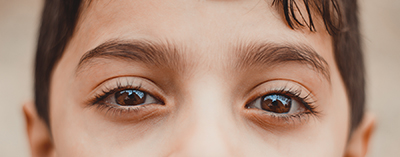What is Lazy Eye?

What Is Lazy Eye?
Lazy eye generally refers to amblyopia (weak eye). Many people make the mistake of saying that a person who has a crossed or turned eye (strabismus) has a "lazy-eye," but lazy-eye (amblyopia) and strabismus are not the same condition. Some of the confusion may be due to the fact that an eye turn can cause lazy eye. In other words, amblyopia can result from a constant unilateral strabismus (i.e., an eye that turns or deviates all of the time).
Amblyopia
Amblyopia is the lack of development of clear vision (acuity) in one or both eyes for reasons other than an eye health problem that cannot be improved with glasses alone. It is a problem with how the brain perceives and interprets the information coming from the amblyopic eye. It often leads to a suppression of the information coming from the amblyopic eye. There are three major types of amblyopia: refractive, strabismic, and deprivational. Read more about amblyopia here.
Strabismus
Strabismus is a misalignment of one or both of the eyes. This misalignment can cause stereo blindness, suppression, amblyopia, and/or diplopia. There are several classifications of strabismus depending on how the eyes are misaligned. Read more about strabismus here.
Convergence Insufficiency
Convergence Insufficiency is a fairly common visual condition which is also (1) confused with lazy eye; (2) not easily discernible to the observer and (3) not detected by the standard 20/20 eye test.
How Many People Have Lazy Eye?
Based on 2010 census data, there were about 18 million people with strabismus and 9.2 million with amblyopia[2] in the United States. About 19.2 million have been diagnosed with lazy eye in the US alone. There are about 2.5 million children under age of 10 with lazy eye, and 250,000 more born every year in the United States. Binocular Vision Dysfunction Pandemic, Dominick M. Maino"[2]
If you think that those are big numbers consider that, "A clinical trial to determine the prevalence of binocular vision dysfunction amblyopia."within the general population suggested the possibility of up to 56% or 60 million men, women, and young adults with symptoms associated with a binocular vision dysfunction."
What Causes Lazy Eye?
First, what is lazy eye? Lazy eye is a common term for a group of disorders called amblyopia and strabismus. Lazy Eye typically begins during infancy and early childhood.
The most common causes of amblyopia are:
- constant strabismus (constant turn of one eye),
- anisometropia (different vision/prescriptions in each eye),
- and/or blockage of an eye due to trauma, lid droop, etc.
Of these, strabismus is the most common cause of amblyopia.
Signs and Symptoms of Lazy Eye
Typical symptoms of Lazy Eye can include:
- Poor depth perception
- Difficulty catching and throwing objects
- Clumsiness
- Squinting or shutting an eye
- Head turn or tilt
- Eye strain
- Fatigue with near work
A clue that your child may have amblyopia is if he or she cries or fusses when you cover one eye.
Treatment for Lazy Eye
Treatment for Lazy Eye (amblyopia) may include a combination of prescription lenses, prisms, vision therapy and eye patching. In vision therapy, patients learn how to use the two eyes together, which helps prevent lazy eye from reoccurring. Vivid Vision is used successfully in the treatment of lazy eye.
Misconceptions about Lazy Eye
Patients are often told that amblyopia can only be treated until a certain age. This is outdated information. While early intervention is still ideal, it is never too late to treat amblyopia.
In many cases you cannot "SEE" a lazy eye. Amblyopia without strabismus, or associated with a small deviation, usually can be not noticed by either you or your pediatrician. This is one reason why an optometric evaluation is necessary in prescribing these disorders.
Another misconception is that the amblyopic eye is the "bad eye." While it doesn't have the same level of eyesight as the non-amblyopic eye, there may be other visual skills, such as localization, at which it is good.
References
- Neural plasticity in adults with amblyopia, Dennis M. Levi and Uri Polat
- The Binocular Vision Dysfunction Pandemic, Dominick M. Maino
You may also be interested in these blog posts:
- What is the difference between Amblyopia and Strabismus?
- What causes lazy eye?
- How to fix a lazy eye
- Vision Therapy Success Stories: Jillian
- Vision Therapy Success Stories: Clayton
_______________________________________
